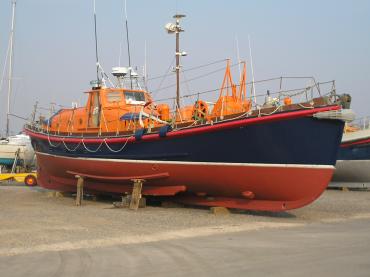Sponsors
National Historic Ships UK acknowledges the financial support of its sponsors
WILLIAM & KATE JOHNSTON was launched in the summer of 1923 and was designed as a prototype lifeboat by James R. Barnett, the consulting naval architect to the Royal National Lifeboat Institution. At the time of her launch, she was believed to be the largest lifeboat in the world. She wasn’t self righting, but was designed to sail submerged in an attempt to get home at all costs. The hull was constructed of timber and was divided into fifteen watertight compartments and the lifeboat was also the first motor lifeboat to be built with flush decks, similar to earlier steam driven lifeboat. She went on station at New Brighton, covering the entrance of the Mersey and replacing the steam lifeboat QUEEN. Her inaugural ceremony took place on 24 September 1924 at the Prince's Landing Stage, Liverpool, where she was named by Mrs. Stewart Johnston. The cost of building her, a sum of £16,084, had been provided out of gifts from Mr. Stewart and his sister Mrs. W. Kendall. Their gifts were supplemented with money raised by the Liverpool Motor Lifeboat Fund. On 24 November 1928, she went to the aid of the French steamer EMILE DELMAS.
She rescued the crew, receiving some damage in the process and set a course home to New Brighton. During the return journey, the lifeboat's bowman and the chief engineer were washed overboard and the engine room was flooded. Although the bowman was picked up, the chief engineer was lost. When she returned to her station, coxswain George Robinson was awarded the silver medal for his efforts and bronze medals went to each crew member. The vessel also received a special award from the Government of France. Another outstanding rescue took place on 23 November 1938. WILLIAM & KATE JOHNSTON went to the aid of two casualties, saving three lives from the first vessel and four from the second. She sustained considerable damage, including three holes to her hull. Although this turned out to be quite serious, it did little to impair her seaworthiness. The silver medal went to coxswain William Jones for skill and courage, and bronze medals were awarded to three other members of the crew. In 1950, WILLIAM & KATE JOHNSTON was sold out of service having saved more than two hundred lives.
She was stripped of her engines, batteries and specialist equipment. Her new owner, James Turner, re-named her JYMPHANY and then fitted her with two Gleniffer paraffin motors. He sailed the boat from the Mersey, to the Caledonian coast and the Thames. The boat was then sold to Mr. L. Law in 1953. He took her to Salcombe where she was converted at Winters Yard, ready for use in 1954. Mr. Law and his family cruised in her to Brittany and ports in the West Country. In 1987, she was sold once again and moved to Hartlepool and later sold again and moored between Ramsgate and Dover. between 2012-2021.
At some point she was fitted with Ford Propulsion twin mk5, 2,5L, engine. In November 2021, her owner purchased the vessel after it had been moored in Dover and began restoring her. In October 2022, the owner sailed the vessel from Dover to Brighton, with the intention of undertaking a further voyage to South Africa to undertake restoration work.
Update, August 2023: New ownership being finalised. William and Kate Johnston has arrived at Boathouse 4 where she will remain moored until funding has been raised for her move to her new permanent home in Merseyside. A new organisation, the William and Kate Johnston Preservation Society, has been set up on Merseyside to return the vessel to Merseyside and restore her as a working vessel.
Update, January 2024: A crowdfunder has been launched to raise funds for transportation of William and Kate Johnston back to Merseyside.
Built by J. Samuel White and Co. Ltd, Cowes, Isle of Wight
Went to aid of French steamer EMILE DELMAS. Rescued crew but damaged during process
Went to aid of two casualties, saving total of seven lives, sustaining considerable damage
Sold out of service having saved over 200 lives. Stripped of engines, batteries and specialist equipment
Bought by James Turner, re-named vessel JYMPHANY and fitted her with two paraffin motors
Sold to Mr L. Law and taken to Salcombe for conversion at Winters Yard
Sold to Mr Dagfinn Asknes and moved to Hartlepool
Renamed NEXUS
Bought by Alexander Thomson and Jill Pearcy. Name changed back to WILLIAM & KATE JOHNSTON
Located at Chatham Historic Dockyard
In private ownership at Ramsgate
Purchased in November 2021 by Charlton Nauschutz
Boat Models, January, 2002
Fry, Eric, Lifeboat Design & Development, 1975
Article in Liverpool Post, 2000
Leach, Nicholas, Saviour of Souls - William & Kate Johnston, The story of a Legendary Prototype Lifeboat, 2001
Morris, Jeff, The Story of the New Brighton Lifeboats, 1986
Barnett, James, Recent Developments in Motor Life-boats of RNLI in Transaction of the Institute of Naval Architects, 1922
Daily Mail, June 2002
Daily Post, June 2002
Liverpool Echo, June 2002
Welsh Chronicle, 2004
Article in East Anglian Daily Times, 2001
If you are the owner of this vessel and would like to provide more details or updated information, please contact info@nationalhistoricships.org.uk

National Historic Ships UK acknowledges the financial support of its sponsors